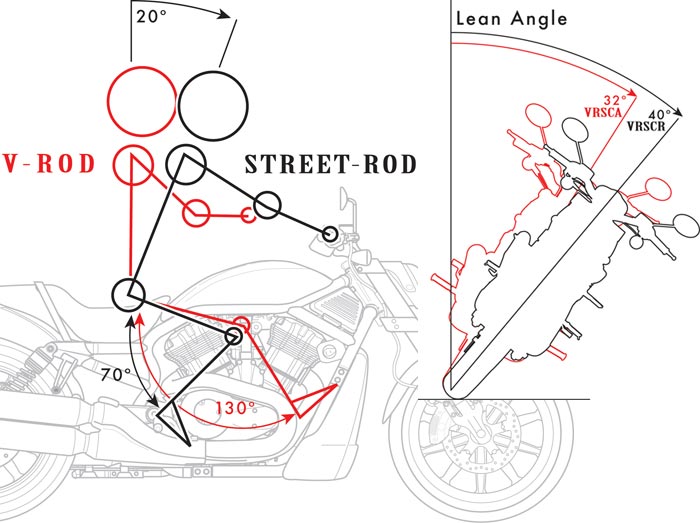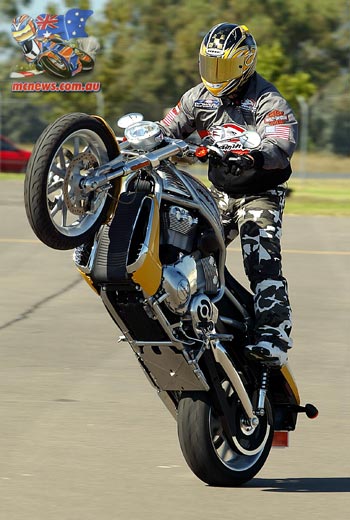I had high hopes for Harley Davidson’s sporting new Street Rod as the original V-Rod was already one of my favourite cruiser style bikes. The lack of rigidity, particularly in the forks and triple clamps, and disappointing ground clearance were my main two complaints while the poor fuel range also scored a mention when I reviewed the original V-Rod model in 2002.
Obviously I was not the only one to make those comments as all this and more has been remedied in the Street Rod.
In fact Harley has gone so far with the improvements to the Street Rod that no other cruiser on the market has a snowballs chance in Hell of keeping the Street Rod in sight once the road tightens up and serious cornering enters the equation. That’s a big call but it’s one that I have no hesitation in making.
The new 43mm inverted forks offer no adjustment and the twin shock rear end only preload adjustment but it certainly doesn’t hold the V-Rod back when things turn serious.
Up and down the tight and thrillingly tortuous Australian Alps roads around Mt Beauty, Mt Hotham and Omeo the Street Rod left me gobsmacked.
It performed more like a sporting nakedbike than a cruiser.
Now I know that more than a few readers will be sniggering into their weeties right now at the idea of the words ‘Harley-Davidson’ and ‘sporting’ being used in the same sentence but make no mistake, this thing is quite a weapon in the tight stuff.
The original V-Rod touched its undercarriage down frustratingly early. However, the new Street-Rod offers plenty of ground clearance and that fact combined with the rigid new front end raises the machine to a whole new level of performance.
In tight sub-80kph corners I have little doubt that a good rider on a Street Rod would be able to stay ahead of an average sportsbike rider in tight terrain.
And yes, I am serious. There was certainly some tight sections of the run up Mt. Hotham that I really don’t think I could have done any faster on a sportsbike. Roads like this will prove happy hunting grounds for Street Rod pilots I’m sure.
And what’s going to make that claim sound even more totally ridiculous is the fact that the Street Rod weighs in at a very hefty 280kg. Now I know your sides are really splitting with raucous laughter at my previous handling comments. And if I was reading this without actually riding the bike I would almost certainly be laughing even harder than you. Once rolling the weight is only noticeable in quick changes of direction where a fair bit of pressure on the bars is required but that’s easily manageable and the specially designed new Brembo brakes cope amazingly well with the mass.
The only time I ever found the weight annoying was picking the machine up off the side-stand. In faster terrain you are aware of the amount of mass being exerted on the front tyre and it’s once the speeds rise that the Street Rod will lose out to more sporting motorcycles in faster corners. The chart below shows the difference in available lean angle between the V-Rod and the Street Rod and also the ergonomic differences between the two models.


The Porsche developed 1130cc V-Rod powerplant also does duty in the Street Rod and offers a few more ponies thanks to a freer flowing exhaust system. Harley claim 120 ponies and my seat of the pants dynamometer tells me that the machine delivers somewhere around 100hp at the rear wheel.
The double overhead cam 60-degree v-twin has four valves per cylinder and forged pistons slide 72mm up and down the 100mm bore. The rev-limiter kicks in at around 8800rpm and the machine pulls well all the way to that mark.
On the standard fairly tall stock gearing the Street Rod can nearly do the 0-100kph sprint in first gear. This doesn’t bode well for dragstrip starts but works well enough on tighter roads as through some really tight and twisty section I could simply leave the Street Rod in first gear.
Drive is transferred to the 180/55-18 Dunlop 207 via a belt drive system. Harley has used this set-up for many years and it has proven itself well. Many owners have enjoyed well over 100,000km from a belt and the primary reason for premature failure is when a sharp rock gets lodged between the belt and toothed drive cog to the extent that it cuts the belt up. To help try and avoid this Harley encases the belt with a cover that even they have not been able to make look good so just remember not to junk it as if you’re unlucky an errant rock can shred your belt instantly. As long as you leave that cover in place you should have no problems.
At the front of the machine a 120/70-19 Dunlop hangs on well and the rims at both ends are Australian made 10-spoke cast items.
The stingy 14 litre fuel tank on the original V-Rod has been stretched to 19 litres for the Street Rod application which can return a generous 300km range. If you are working the machine hard though the tank can be drained in less than 200km but you do have to be going some to do it. Refueling the V-Rod is accomplished by lifting the seat, which is on a hinge perpendicular to the bike, to find the plastic filler cap on the plastic fuel cell.
A needle style fuel gauge is always visible on the dash and a low fuel warning light illuminates when there is around four litres remaining. This part of the instrumentation works well enough but unfortunately the raked angle of the cluster housing means that once in a riding position it is nearly impossible for someone of my average 5’10” height to read the LCD panel that displays the odometer.
Changing gears through the five speed gearbox is great compared to most cruisers but is still no snick-snick sportsbike box. It does work quite well as long as you remain positive with your foot. Looking at the changes of direction and numerous linkages the shifter has to go through to actually make it to the shift fork it really is a wonder that it works as well as it does.
The build quality of the Street Rod does seem to be quite good. I had my example regularly banging its 8,800rpm rev-limiter and the only thing that vibrated loose was a mirror but that’s nothing unusual as I’ve had this happen on plenty of Japanese naked bikes that have a similar locking nut system and my Street Rod was the only one of the assembled troupe to rattle anything loose. Likewise no drips of anything were to be seen underneath any of the bikes no matter how spirited the strop had just been. The fan on my bike did come on quite regularly but I think this could be a sign that the thermostat switches the fan on much earlier than on most Japanese machinery as the bike never seemed to get hot and bothered.
The machine I rode was fitted with the optional screen and I never experienced any problems with buffeting at all, while another rider of similar height did complain of buffeting from the screen so I can only put that down to the fact that he must have been sitting a little different to me.
While on the subject of sitting I must say the Street Rod certainly felt more comfortable to the bum than I remember the V-Rod being. I’m not sure if they have changed the seat all that much from the original model or it is the superior control that the improved rear suspension provides but I certainly had no problems this time around and didn’t have the problems with the lip leading up to the pillion perch poking me in the back like I experienced on the earlier model. I don’t think big days in the saddle will pose any serious problems to most riders.
The seat height is considerably taller than the original V-Rod though and those much shorter than around 5’8” might struggle a little with car park maneuvering chores. The pillion pad is not a place for anyone that you wish to remain on friendly terms with.
What would I change on the Street Rod?
Not too much but something I would certainly look for a solution for is the position and bend of the rear brake lever. The first aftermarket company to come up with some trick adjustable footpeg hangers with a revised rear brake lever is going to make a mint. The rear brake lever can’t be adjusted and is positioned extremely high and close to the side of the machine. This makes it damn hard to use. In fact the only time it didn’t annoy me was when I was hanging off the opposite side of the bike in left hand corners which made it easier for my foot to be high enough to use the rear brake. I did learn to live with the situation after a few hundred kilometres but would almost certainly be looking for an improved set-up if taking a Street Rod home to live with.
The switchgear is regular Harley stuff which works well enough but I don’t think it suits the Street Rod. The big and chunky look and feel might work on a Fat Boy but I would prefer something a little more minimal and deft to the touch for the Street Rod. A set of high bend Renthals with aftermarket switchgear anyone? The starter switch is now located on the right hand side of the machine just below one of the frame cross braces which will suit some and not others.
There are four colours to choose from with a silver frame that include Black Cherry, Rich Sunglo Blue, Mirage Orange and Yellow Pearl while there is also a black framed model with Vivid Black paintwork on the panels. Oddly enough you can’t get the Street Rod in that lovely silver that the original V-Rod came in which is a bit of a shame.
Harley back the machine with a 24 month unlimited kilometre warranty and the servicing requirements are quite manageable with the initial check over scheduled at 1600km followed by minor services every 8000km and valve clearance checks every 16000km.
Overall I rate the Street Rod certainly at the top of the sporty cruiser list. The icing on the cake is that at $27995 the new Street Rod comes in a couple of grand cheaper than the original V-Rod.
SPECS – Harley-Davidson Street Rod
Engine: 1130cc, Liquid-cooled 4-stroke v-twin
Bore x Stroke: 100 x 72mm
Compression: 11.3:1
Induction: Fuel injection
Starter: Electric
Transmission: Five speed
Final Drive: Belt
Wheelbase: 1,697mm
Seat Height: 787mm
Dry Weight: 280kg
Fuel Capacity: 19 litres
Tyres: Front _ 120/70-19; Rear _ 180/55-18
Suspension: Front _ 43mm inverted forks; Rear _ Twin shock
Brakes: Front _ 300mm discs, Brembo four-piston calipers; Rear _ 300mm single disc, Brembo caliper
Price: $27995
Warranty: Two years, unlimited kilometres























